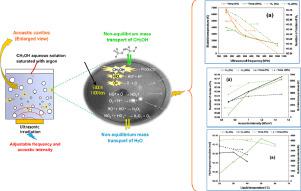Chemical Engineering and Processing: Process Intensification ( IF 3.8 ) Pub Date : 2022-07-30 , DOI: 10.1016/j.cep.2022.109080 Aissa Dehane , Slimane Merouani , Oualid Hamdaoui , Muthupandian Ashokkumar

|
A comprehensive numerical investigation was conducted to analyze the effect of ultrasound frequency (213-1000 kHz), ultrasonic intensity (0.7-1.5 W/cm²) and medium temperature (293.15-333.15 K) on the production of hydrogen from methanol decomposition inside acoustic bubbles (methanol sono-conversion). The adopted model was firstly compared with some reference data. It was found that in the absence of methanol (in the presence of methanol), the bubble temperature, hydrogen production (and methanol conversion) are decreased monotonously with an increase in frequency. The maximal bubble temperature is slightly impacted by the presence of methanol under ultrasonic frequencies that are equal to or greater than 515 kHz. In addition, the yield of H2 is larger in the presence of methanol, regardless of the utilized frequency. Between 213 to 355 kHz, methanol conversion and hydrogen production are most efficient. Both H2 production and CH3OH degradation are accelerated under an ideal acoustic intensity of 1 W/cm2. At a liquid temperature of 303.15 K, a turning point in bubble temperature may be noticed in the absence of methanol, and at a liquid temperature of 323.15 K, the highest hydrogen production can be achieved. Hydrogen production and methanol conversion are most efficient at liquid temperatures between 293.15 and 303.15 K.
中文翻译:

加工条件对甲醇声波转化制氢的影响:采用经过验证的模型进行的数值研究
进行了全面的数值研究,分析了超声频率(213-1000 kHz)、超声强度(0.7-1.5 W/cm²)和介质温度(293.15-333.15 K)对声泡内甲醇分解制氢的影响(甲醇声转化)。首先将所采用的模型与一些参考数据进行了比较。发现在没有甲醇的情况下(在甲醇存在的情况下),气泡温度、氢气产量(和甲醇转化率)随着频率的增加而单调下降。在等于或大于 515 kHz 的超声波频率下,最大气泡温度受甲醇存在的轻微影响。此外,H 2的产率无论使用的频率如何,在甲醇存在下都更大。在 213 至 355 kHz 之间,甲醇转化和氢气生产效率最高。在 1 W/cm 2的理想声强下,H 2的产生和 CH 3 OH 的降解都得到了加速。在 303.15 K 的液体温度下,在没有甲醇的情况下可能会注意到气泡温度的转折点,而在 323.15 K 的液体温度下,可以实现最高的氢气产量。在 293.15 和 303.15 K 之间的液体温度下,氢气生产和甲醇转化效率最高。











































 京公网安备 11010802027423号
京公网安备 11010802027423号